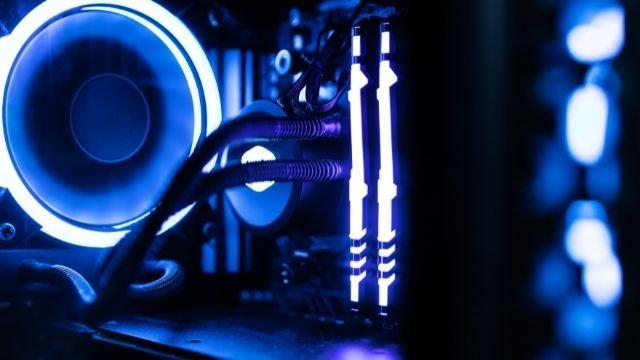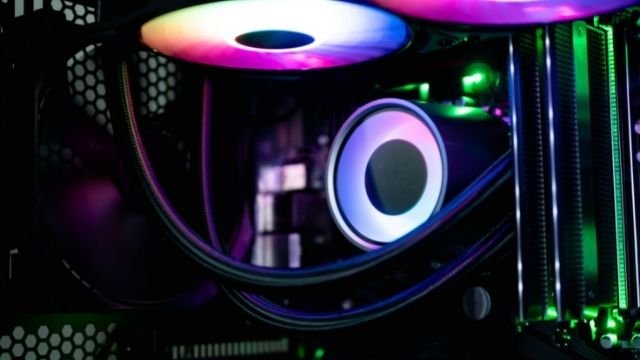Do you Need Thermal Paste with Liquid Cooling?
You’ve been using air cooling for years, but finally bought yourself a nice liquid cooling rig and are ready to install. But wait… liquid cooling is better than air cooling, right? So we don’t need to use thermal paste… right? Not quite. Liquid cooling is in general more effective than air cooling, but thermal paste is not just a component of an air cooling system. Thermal paste helps any cooling system perform to its highest efficacy.
Keep reading to learn how.
How does liquid cooling help to cool down CPU?
Before we talk about thermal paste, lets get a sense of how the liquid cooling system works. If you’re familiar with air cooling, then you know that in order to dissipate the heat being generated by the CPU, the heatsink needs to first draw heat out of the CPU into a large aluminum plate with more surface area, then use a medium to disperse it.
In the case of air cooling, the medium is the air inside your case. Fans help to push out hot air from one end while drawing in cold air from the other end. In this way, you PC constantly cycles through fresh air which it uses to dissipate the heat coming off your CPU.
The concept with liquid cooling is similar – except instead of using air, we use water (coolant)… and a little bit of air. For liquid cooling, the CPU isn’t attached to a heatsink but to a water block (sometimes referred to as a baseplate). Although the name is different, the function is the same – to take in the CPU’s heat. However, from that point on, the process differs. Instead of drawing the heat into a larger surface area, we draw it into water. Then, the water is cycled into a highly-efficient radiator attached to a fan which quickly cools the water and cycles it back to the water block for a second round.
By more efficiently distributing water over more surface area (the radiator), the result is better overall cooling and quieter fan speeds when compared to traditional air cooling. (Though we sometimes say “water cooling” or use “water” to talk about the medium in a liquid cooling system, other coolants like glycol and dielectric fluid can also be used.)
Is thermal paste mandatory in liquid cooling?
The short answer is: yes.
Many people often confuse thermal paste as being “less than” in a computer, and unnecessary when more expensive components are installed. In fact, thermal paste is necessary regardless of what components are being installed. Within the realm of liquid cooling, you’ll be using either an AIO or a custom loop.
AIO
AIO stands for “All-In-One”, and as you might’ve already guessed, it includes everything you need out of the box. An AIO includes the water block, pump, radiator, tubes, fans, and fittings already put together so you can immediately install it without having to fiddle around with all the pieces.
AIO setups are suitable for beginners in liquid cooling who don’t want the risk of a fitting coming undone and spraying water all over their case. While AIO’s do not completely eliminate the risk of a valve clogging or a fitting coming undone, they do greatly decrease it if you’re a beginner. AIO’s often come RGB-ready which is also great for quick aesthetics.
Custom Loop
If you take a look at any two AIO’s, aside from minute details, they would mostly look the same – a small water block and pump, attached to 2 tubes, which run to the radiator and attached fans. The number of fans, look of the tubes, etc. may vary. However, most parts are the same. If you’re adventurous, or an enthusiast and want to step out of the mold, then you’ll want to build a custom loop.
A custom loop has essentially the same parts as an AIO – water block, pump, tubes, fans, radiator, and fittings. But each piece can be customized to your liking. Custom loops are often found in high-end PC’s like the kind you find with 4000 upvotes on /r/pcmasterrace – and rightfully so because building your own custom loop requires a higher level of expertise than simply throwing on an AIO. Every piece of the loop should be picked out and put together to make sure it functions properly – it’s almost like building another smaller computer.
Regardless of which one you choose, thermal paste will play the same role. Recall that thermal paste serves 2 purposes – it is a gap filler and a thermal conductor. In an air-cooled build, thermal paste if put between the CPU and the heatsink, allowing heat to freely flow from the CPU and be dissipated by the heatsink and the fan, as we previously discussed.
In a water-cooled build, thermal paste functions the same way. But instead of being between the CPU and the heatsink, it is instead spread between the CPU and the water block. This way, the thermal paste fills the gaps between the surface of the CPU and the water block and allows heat to more efficiently be transferred into the water.
Why is the quality of thermal paste more important in liquid cooling than in air cooling?
Don’t let the title mislead you – thermal paste is equally important in both air cooling and water cooling. However, it is only more important in water cooling when compared to cost. With air cooling, there is a standard expected efficiency. If you have a basic air cooling setup that you paid $50 for then you’re expecting $50 worth of cooling. But if you just dropped $300 on an AIO, then you expect to get your money’s worth – without good thermal paste, you will never hit that level of efficiency.
No matter how good your water cooling setup is, if the thermal paste isn’t good enough, the heat will be stuck in the space between the CPU and the water block.
How to apply thermal paste in a liquid cooling system
Applying thermal paste in a liquid-cooled system is as easy as applying thermal paste in an air-cooled system, except instead of the heatsink, you’ll be using a water block.
1. Make sure your computer is turned off and all wires have been unplugged from the back.
2. (If you’re replacing the thermal paste) Unscrew the screws which attach your water block to the CPU and gentle lift it off.
3. Clean off any old thermal paste with isopropyl alcohol and a paper towel or cotton swab (or for best results, use our Kooling Monster KLEAN-01 specially-formulated thermal paste wipe)
4. Wait 2 minutes for the alcohol to evaporate.
5. Apply about a pea of thermal paste to the top of your CPU (or use one of the other patterns listed here)
6. Carefully put the water block back on top of the CPU and screw it into place.
7. Check around the sides of the CPU/water block for any leakage.
8. If there are leaks, use a thermal paste wipe to wipe them away.
9. If there are leaks into the pins, unscrew the water block and use the methods here to clean up and try again.
If you’re an enthusiast or just someone looking to get into liquid cooling, there’s a lot to play around with. Liquid cooling is a great way to keep your computer running cool, quiet, and at its top performance. But not without thermal paste. Remember to always apply thermal paste when installing any new cooling components, air or liquid. Without thermal paste, an air cooler can’t do its job and a liquid cooler might as well be running dry.





